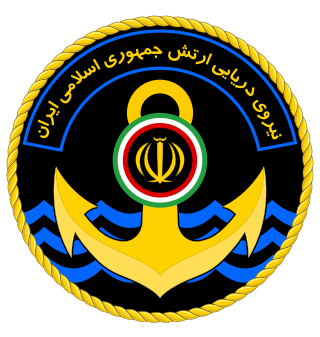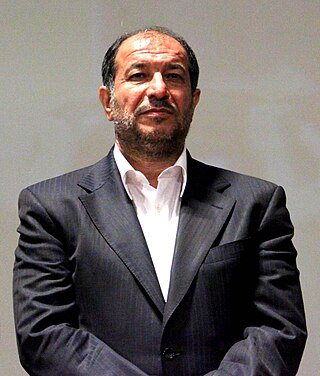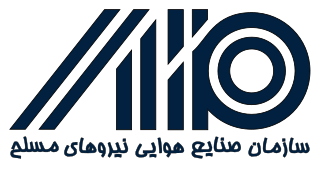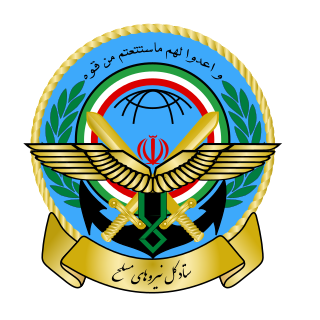
The Islamic Republic of Iran Navy, officially abbreviated NEDAJA, is the naval warfare service branch of Iran's regular military, the Islamic Republic of Iran Army (Artesh). It is one of Iran's two maritime military branches, alongside the Navy of the Islamic Revolutionary Guard Corps (IRGC).

Mostafa Mohammad Najjar is an Iranian politician and retired IRGC general. He was interior minister of Iran from 2009 to 2013 and minister of defense in the first cabinet of Mahmoud Ahmadinejad from 2005 to 2009. He is also a veteran of the IRGC.
The military history of Iran has been relatively well-documented, with thousands of years' worth of recorded history. Largely credited to its historically unchanged geographical and geopolitical condition, the modern-day Islamic Republic of Iran has had a long and checkered military culture and history; ranging from triumphant and unchallenged ancient military supremacy, affording effective superpower status for its time; to a series of near-catastrophic defeats at the hands of previously subdued and conquered peripheral nations, most notably including the ancient Greek kingdom of Macedon as well as the Asiatic nomadic tribes at the northeastern boundary of the lands traditionally home to the Iranian peoples.
Iran's military industry manufactures and exports various types of arms and military equipment. Iran's military industry, under the command of Iran's Ministry of Defence and Armed Forces Logistics, is composed of the following main components:

The Fajr-3 is an Iranian heavy 240 mm intermediate-range multiple-launch artillery rocket (MLRS). The Fajr-3 is a license-built copy, with slight modifications, of a North Korean MLRS called the M-1985. The Fajr-3 was introduced in the 1990s and has since been exported to Hamas and Hezbollah.

Iran Electronics Industries or Integrated Electronics Industries(IEI, Persian: صنایع الکترونیک ایران; also known as Persian: صاایران, Sâlairan) is a state-owned subsidiary of Iran's Ministry of Defense. It is a diversified organization with operations in electronics, optics, electro-optics, medical equipment, communications, computer and semiconductors.

The Raad or RAAD is an Iranian wire-guided anti-tank guided missile based on the Soviet 9M14M Malyutka missile. The Raad began mass production in 1988 and was publicly unveiled in 1997. It is manufactured by Parchin Missile Industries, a subsidiary of Iran's Defense Industries Organization.

The Toophan is an Iranian SACLOS anti-tank guided missile reverse-engineered from the American BGM-71 TOW missile. The Toophan 1, an unlicensed copy of the BGM-71A TOW missile, began mass production in 1988 and the Toophan 2, a BGM-71C ITOW variant, was publicly shown in 2000.

The Iran Aviation Industries Organization (IAIO), also known as the Aerospace Industries Organization, is an Iranian state-owned corporation established in 1966 for the purpose of planning, controlling, and managing the civil & military aviation industry of Iran. The Aerospace Industries Organization acts as both an OEM, directly manufacturing aircraft and aerospace products, and as a conglomerate, holding other Iranian state-owned aviation corporations.
The defense industry of Russia is a strategically important sector and a large employer in Russia. Combined, the US and Russia account for 57% of all major weapons exports.

The Iranian Armed Forces, officially the Islamic Republic of Iran Armed Forces, are the combined military forces of Iran, comprising the Islamic Republic of Iran Army (Arteš), the Islamic Revolutionary Guard Corps (Sepâh) and the Law Enforcement Force (Police).
The policy of the Soviet Union towards the Iran–Iraq War from 1980 to 1988 varied, beginning with a stance of "strict neutrality" and moving towards massive military support for Iraq in the final phase of the war. The war was inconvenient for the USSR, which had aimed to ally itself with both Iran and Iraq. In the first period of the war, the Soviets declared a policy of "strict neutrality" towards the two countries, at the same time urging a negotiated peace. Iraq had been an ally for decades and the Soviets had tried to win over Iran as well, but their offers of friendship were rebuffed by both the pro-Western Shah and the Ayatollah of Iran. After the Iranian revolution, the Islamic Republic established its slogan as "neither East nor West." In 1982, the war turned in Iran's favor and the Iranian leader Ayatollah Khomeini pledged not to stop the conflict until he had overthrown the Iraqi president Saddam Hussein. Such a prospect was unacceptable to the Soviet Union, which now resumed arms sales to Iraq while still maintaining an official policy of neutrality. The Soviets also feared losing Saddam's friendship with the West. After further Iranian gains in 1986, the Soviet Union massively increased its military aid to Iraq. The Soviets were now afraid of the Iranians encouraging Islamic revolution in Central Asia. Soviet aid allowed the Iraqis to mount a counteroffensive which brought the war to an end in August 1988.

Israel's role in the Iran–Iraq War consisted of support provided by Israel to Iran during the Iran–Iraq War from 1980 to 1988. During the war, Israel was one of the main suppliers of military equipment to Iran. Israel also provided military instructors during the war and direct support to Iran's war effort, when it bombed and destroyed Iraq's Osirak nuclear reactor, during Operation Opera. The nuclear reactor was a central component of Iraq's nuclear weapons program.

The Ministry of Defence and Armed Forces Logistics is the defence ministry of the Islamic Republic of Iran and part of the country's executive branch. It thus reports to the President of Iran, not to the Commander-in-Chief of the Iranian Armed Forces.

The Imam Hossein Comprehensive University is a public university located in Tehran, Iran.

Mohammad Reza Pahlavi, also known as Mohammad Reza Shah, was the last Shah (King) of the Imperial State of Iran from 16 September 1941 until his overthrow in the Islamic Revolution on 11 February 1979. Owing to his status, he was usually known as the Shah.

Malek Ashtar University of Technology (MUT) is a public research university of engineering, science in Iran. Founded in 1984, MUT's main campus is located at Tehran, the capital of Iran. Its other campuses are located in Isfahan and Urmia. The university is named after Malik al-Ashtar, one of the most loyal companions of Ali Ibn Abi Talib.
The defense industry of Israel is a strategically important sector and a large employer, as well as a major supplier of the Israel Defense Forces. Israel is one of the world's major exporters of military equipment, accounting for 10% of the world total in 2007. Three Israeli companies were listed on the 2017 Stockholm International Peace Research Institute index of the world's top 100 arms-producing and military service companies: Elbit Systems, Israel Aerospace Industries and RAFAEL. The Defense industry in Israel is a strategically important sector and a large employer within the country. It is also a major player in the global arms market and is the 6th largest arms exporter in the world as of 2014. Total arms transfer agreements topped $12.9 billion between 2004 and 2011. There are over 150 active defense companies based in the country with combined revenues of more than $3.5 billion annually. Israeli defense equipment exports reached $7 billion in 2012, making it a 20 percent increase from the amount of defense-related exports in 2011. Much of the exports are sold to the United States and Europe. Other major regions that purchase Israeli defense equipment include Southeast Asia and Latin America. India is also major country for Israeli arms exports and has remained Israel's largest arms market in the world.

The Khordad 15 is an Iranian designed and built surface-to-air missile (SAM) system. The system was unveiled to the public on 9 June 2019 in an address made by Iranian Defence Minister Amir Hatami in Tehran, Iran. The system was developed by the Iran Aviation Industries Organization (IAIO). It shall have the capability to detect and intercept fighter jets, stealth targets, unmanned combat aerial vehicles (UCAV) and cruise missiles. It operates in conjunction with Sayyad-3 missiles. The surface-to-air missile system was developed in order to counter missiles and other aerial threats presented by the presence of extra-regional forces at military bases in countries around Iran. It was unveiled amid escalating tensions with the United States and Europe's failing attempts at upholding its commitments to the 2015 Iran nuclear deal.
Reza Azimi was a senior military officer during the reign of Shah Mohammad Reza Pahlavi. He was a general and held various military and government posts, including commander of the Imperial Iranian Ground Forces and minister of war.















